|
Features,
Honors
& Awards, Ag
Announcements
Ag News Elsewhere
(fresh daily from the Web)
|
|
Features
|
|
|
|
|
Logan
County crops ó a varied picture
[JULY
26, 2001] Logan
County has become a varied picture in agriculture over the past few
weeks. With critical timing from the first week of July to date for
corn, much-needed rainfall fell in some areas. Other areas were
virtually shut out. Pictured below is an ear of corn with poor
pollination due to heat stress at a critical time.
|
|
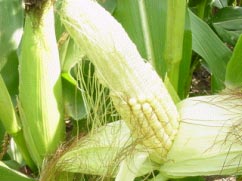
Also
noticeable in area cornfields was the firing of lower leaves due to
the heat and moisture stress, as plants protected themselves and
continued filling kernels on the ear.
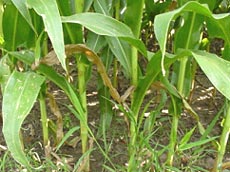
Insect
damage was also seen, with rootworm beetles causing some silk
clipping and corn borers riddling some stalks.
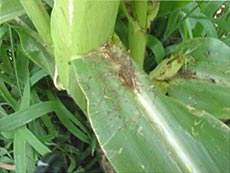

Soybeans
have a critical point approaching as they start the pod-fill period.
They continue to bloom, set pods and begin to make the seeds grow.

[to top of second column in
this article]
|
Many
insects, such as bean leaf beetles and grasshoppers, have caused
some minor defoliation in the soybean leaves.

For
the horticulturalist in us, we have seen the wilt virus transmitted
by beetles in the cucurbits, such as pumpkins and cucumbers.
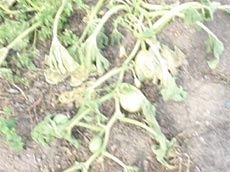
And
lastly we have a problem we can take care of. That is damage by
potato leafhoppers. It is indicated by a brown or black
"V" at the tip of leaves. A simple spray treatment of
diazinon or carbaryl will prevent further damage. This picture
happens to be a rose.
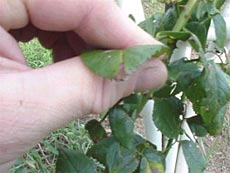
Not
all is bad, but it does make for some more dramatic pictures. If
weather could be custom-ordered, it would involve about an inch of
rain a week (and more than a tenth or two at a time would be nice),
high temperatures of about 85 degrees and lots of sun.
The
next items coming to Lincoln Daily News from the Extension
office will be fair photos. The Logan County Fair will officially
open on July 31 and will run through Aug. 5. The 4-H shows have
already begun, with foods and clothing exhibited before the fair.
Dogs will show on the Saturday before the fair, and most project
divisions will be shown on the Monday before the fair. Hope to see
you there!
[John
Fulton]
|
|

|
|
|
New
techniques keep streams
from carrying away farmland
[JULY
24, 2001] "Ninety-three
percent of Logan County is farmland, and 97 percent of that farmland
is prime land ó
thatís as good as you get," says Bill
Dickerson. Preserving that prime black soil is a high priority for a
group of local and national organizations.
[Click
here for more photos]
|
|
A
field day sponsored recently by the Logan County Soil and Water
Conservation District and the Land of Lincoln Soil Savers gave area
farmers a look at a new stream stabilization technique, one way to
control soil erosion. These two groups, along with the U.S.
Department of Agriculture Natural Resources Conservation Service and
the Illinois Department of Agriculture are working on projects to
prevent Logan Countyís waterways from carrying away its farmland.
"With
three good-sized creeks in the county ó
Salt, Kickapoo and Sugar Creeks ó
itís a never-ending job," Dickerson says. As
a district conservationist for the NRCS, Dickerson works closely
with Logan Countyís Soil and Water Conservation District.
On
Thursday he took a group of area farmers to a Kickapoo Creek site
southeast of Atlanta, on farm ground owned by Dave Evans and Dan
Koons, to explain a new technique called the stream barb system.
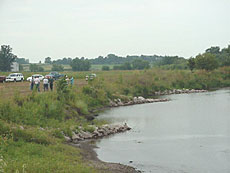
[These
three rock projections are a new stream stabilization technique
called barbs. Pointing
upstream, they work together to redirect the water in Kickapoo Creek
toward the middle of the creek and keep it from undercutting the
stream bank.]
What
the farmers saw were three projections of large stone riprap jutting
out into the creek, angling upstream, at a point where the creek had
been cutting away the bank. The barb-shaped stone projections work
together to catch the current and redirect it to the middle of the
stream, away from the bank which is being eroded.
The
project was completed in December of last year, and, according to
the landowners, is working just as predicted.
"A
few weeks ago, when the water was higher, I could see it working. I
could actually see water turn and go back into the channel,"
Koons said.
Before
the barbs were put in, he added, the bank went straight down,
because it was being undercut by the creek at the rate of at least a
foot a year. Now the stream bank slopes, maintaining the angle it
was given by the construction crew that put in the new stabilization
system. The bank is also being held in place by the natural
vegetation that is beginning to grow there.
The
new stream barb system is protecting about 600 feet of the bank of
Kickapoo Creek, Dickerson says, preventing the loss of about
one-half ton of soil per foot per year. That means 300 tons of prime
topsoil is no longer washing down the creek, eventually ending up
somewhere in the Gulf of Mexico.
It is
the nature of streams and rivers to meander, traveling in a series
of S-curves, as they slow down and broaden out their flood plains,
Dickerson explains. Formerly, engineers tried to keep streams from
eroding the land around them by straightening them out, a process
called channelizing. Kickapoo Creek was channelized on the Koons-Evans
farm in the mid-1970s, when the land belonged to a different owner.
But
the channelizing couldnít prevent the creek from reverting to its
natural tendency to meander, and it soon began cutting into the land
again. (Itís now against federal law to straighten a stream.)
Today
the idea is to work with nature, allowing the stream to meander but
preventing it from meandering too much, Dickerson explains.
"Moving water is one of the strongest forces on earth. We are
now going with the natural force of the stream, rather than fighting
it."
[to top of second column in
this article]
|
Although
itís the newest technique, the stream barb system on the Koons-Evans
farm isnít the only system on Kickapoo Creek that is keeping Logan
County soil in Logan County. Two different projects upstream, called
bendway weirs and similar to the barb system, are on land owned by
Rodney Alberts and Jerry Cisco. They were also installed with the
help of Dickerson and the Soil and Water Conservation District.
These
stream stabilization systems not only save soil, they also
contribute to better water quality. They prevent streams from
filling up with sediment and also prevent agricultural chemicals and
nutrients from draining into waterways. Dickerson says the weirs and
barbs are also good for wildlife. A degrading stream is sterile,
providing little or no natural habitat. Rock bars, however, make
good aquatic habitats, places for fish to hide or breed.
Dickerson
explained the process of constructing the stream barb system to the
group of about 30 farmers who came to the site, pointing out that
the average cost of installing such a system on a Logan County farm
would be about $11,000. However, the Illinois Department of
Agriculture has a $1 million program in place this fiscal year (July
1, 2001 to June 30, 2002) to help fund stream stabilization, and
farmers who put in an approved system can get as much as 75 percent
of the cost reimbursed.
Several
construction firms in the area do the work, Dickerson said, and the
NRCS is ready to help farmers do the paperwork. A steam
stabilization project usually takes about a year from start to
finish because of the permits required -- from the U.S. Army Corps
of Engineers, the Illinois Environmental Protection Agency and the
Illinois Department of Natural Resources.
The
NRCS has been doing stream stabilization projects for the past 10
years, along with a number of other conservation programs. These
include no-till farming, which according to Dickerson has
contributed more to soil erosion control than any other program, and
the Conservation Reserve Program, the USDAís most popular
conservation program. CRP allows landowners to take cropland out of
production for as much as 15 years, getting payments of as high as
$192 an acre for the idle land. The land can be put in grass for
erosion control or planted with trees. Most land in CRP is already
environmentally sensitive, Dickerson says, often located on a flood
plain or on sloping ground.
After
viewing the stream barb system, the farmers adjourned to the Atlanta
Park shelter, where they heard a program by Howard Brown, agronomist
with Growmark of Bloomington. Brown walks the fields, looks at crops
for indications of insects, fungus and other plant diseases, and
gives farmers an update on how the season is progressing and what to
look for when making decisions for next yearís planting.
Brown
said the yield potential for area crops this year looks good
"if the weather is good from here on out."
Anyone interested in more
information about stream stabilization or other conservation
practices may call the Soil and Water Conservation District office
at (217) 732-2010, Ext. 3.
[Joan
Crabb]
|
|
|
Soybeans
101
[JULY
2, 2001] After
the short course on corn, it is only fitting to provide a brief
description of soybeans. Most people know what a soybean seed looks
like. It is round and has two halves. These halves will later become
the cotyledons (seed leaves). The hilum is the seed scar where the
seed was attached to the pod, much like a pea. The embryo of the
plant is attached between the two seed halves.
|
|
The
germination process is triggered when adequate moisture is available
to swell the seed and the temperatures are generally over 60 degrees
in the soil. The soybean is quite different than corn in that the
cotyledons (seed halves) are actually raised out of the soil by the
shoot as it grows longer. The cotyledons provide food for the young
plant until leaves provide food through photosynthesis.
After
the cotyledons, a pair of unifoliate leaves comes out. The growing
point of the soybean plant is the top part of the plant and always
exposed. After the unifoliate leaves, the trifoliate leaves begin to
emerge. These are the leaves that have the regular three leaflets
that will make the food for the plant and seed for the remainder of
the growing season.
Soybeans
bloom based on the length of the night. This means that the earlier
varieties begin in late June and the other varieties commonly grown
in our area will follow within the next 10 days or so. Most soybeans
grown in the Midwest are of the indeterminate variety, which means
they will continue to bloom and add leaves until they begin to die.
[to top of second column in
this article]
|
Many
of our soybean fields will have only about 25 percent of the flowers
actually develop into pods and produce seed. Most plants in a field
will have 30 to 100 pods on them, with two to three seeds per pod.
One way we estimate yield is to figure four bean seeds per square
foot equals a bushel.
Soybean
plants normally ripen in the months of September and October,
depending on the maturity of the plants used. Most maturities in our
area are either Group 2 or Group 3 varieties. Normal yields are from
40 to 60 bushels per acre, depending on variety, fertility,
management and weather. The weather is the big factor each year in
determining yields.
[John
Fulton]
|
|
|
Honors
& Awards
|
|